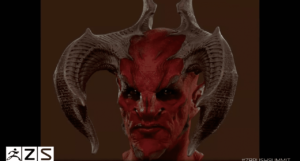Gnomon Live Melbourne
Gnomon Live is a celebration of everything digital VFX, where like minded animators and artists come together to share their passion for creation and learning. Spanning 2.5 days, attendees were given the opportunity to see some of the world’s leading VFX artists create amazing digital art before their eyes. The demonstrations ranged from digital sculpting, shot fixing, rendering and compositing as well as innovations in games and digital pipelines in general. The event also brought together industry representatives from local animation companies who were available for Q&As and networking. In every room there was some kind of digital creature either being sculpted or brought to life.
It did seem quite an odd contrast to be seeing so many digital monsters coalescing within the serene beauty of Abbotsford Convent: a meeting of angels and demons.
The first apparition was the king of creatures Neville Page, the principle character designer of Avatar, who literally turned himself into the devil. This demon-stration was showing an absolute bleeding-edge technique that combines face-scanning, digital sculpting and 3D printing to revolutionize makeup prosthetics. What used to be more than an 8 hour procedure has been reduced to a 15 minute application. Neville’s head was first digitally scanned. He then took his own scan data into ZBrush to repurpose this structure into the demon we see below.


Both his sculpting and painting are done in ZBrush. The genius stroke is how ZBrush can then extract the original shape from the final sculpt resulting in a perfect digital skin that when printed carefully to scale formed a perfect fit for Neville’s unique facial structure.
We marvelled at the creation of a true cinematic masterpiece, Ningyo by Migel Ortega and Tran Ma. Both texture and modelling artists turned all-round digital filmmakers. They gave up their day jobs to produce a labour of love on a shoestring. But you wouldn’t think so looking at the sumptuous images of mysterious creatures and dark hallways of a time long past. The Ningyo is the story of a cryptozoologist who, despite the jeering of his academic contemporaries, undertakes a quest to find the legendary Ningyo, a kind of mermaid deeply feared in Japanese folklore which is rumoured to bring immortality to those who eat its flesh, but with the price of eternal torment.
What was truly incredible about this production was that it was entirely created within their house. Between the 30 computer renderfarm, ladders, paint and makeshift greenscreens, the couple managed to complete every facet of the production (except for one desert location shot) within their own four walls with their own resources. A true inspiration to any filmmaker who finds themselves feeling under resourced or limited in scope – turns out that the only limitation we have is our imagination and our skills.
It was a rare pleasure to see both Miguel and Tran share their experiences on a human level as well as on an intimate “warts and all” technical level. I asked them to explain the technical approach they used to manage the incredible complexity of their images. The answer was raw and honest: no tricks, everything – absolutely everything was modelled down to the last polygon… and rendering, well it just took a very very long time. Some single frames they said took more than 30 hours.
We were able to see the problems they faced and the solutions they came up with. Tran led a detailed voyage into the creation of the cat-bat shown above with a lean production perspective. She showed not just how to create good topology in modelling, but why is it important in the grander scale of a film production, its implications in texturing, shading, look dev, shot fixing and rendering.
Migel however forever changed my views on the colour integration of 3D images. Migel is a talented teacher and in 10 minutes cured me of a lifetime of colour anxiety. His demo in Nuke showed us a simple and foolproof way to perfectly match colours in a VFX composite.
It’s all down to RGB, but not the RGB you are used to. Red, Green and Blue are actually all greyscale channels and while we may have varying abilities to see colours, most of us can tell the difference between black and white. So if you can match the black and white of the Red, Green, and Blue greyscale channels, you can match any colour you want. The evidence is in the clip above, all disparate 3D elements, but perfectly blended. The holy grail of any CG Artist is within your reach.
For students looking out at the bigger scarier world of employment, I can relay to you many gems particularly from Alex Alvarez, the founder of Gnomon, Raphael Pimentel of Luma and Alex Bex of Playside Studios. The main takeaway from these careers sessions were twofold: know the right software and specialise in what you do.
There were some amazing new applications demonstrated but it is clear that if you want to get work in the VFX industry you need to know Maya. In every area of the pipeline shown, Maya was the supporting cornerstone. In modelling it was Maya and ZBrush, in games it was Maya and Unreal, in VFX and compositing it was Maya and Nuke. If there was any clear direction to be given it was that you must learn Maya in today’s industry.
Raphel Pimentel made a simple but significant statement about what you need in your showreel to be taken seriously by a studio. Your reel needs to show that you can do anything that they need you to do. You need to view your reel as a proof of competency not just a montage of what you like to create.
For example, an animation reel needs to show that you can handle not just body mechanics and performance, but the mechanics and performance of bipeds, quadrupeds, birds, fish etc. Performance should also cover the broad and subtle, facial animation and dialogue. That covers all the areas they need.
Cover all bases and you will get an interview
Alex Alvarez made the comment however that your reel is only 50% of what studios are looking for. The other 50% is your personality. In a production, you will have to spend long hours cooperating together so how you may get along with others is scrutinised heavily in an interview. So don’t just polish your reel. Polish your persona and there is a good chance of being seen.
Studios want education facilities to know what their needs are so that we can create the students they want to employ: in particular Alex Bex from Playside Studios told me that he is very keen to get more engagement from the education sector. They’d prefer to not spend weeks bringing a new hire up to speed on their choices of software. Which is for the most part – Maya.
I discussed the various modes of educational deployment with Alex Alvarez and he had some very interesting observations. Face to face education is still hands down the most effective means to create successful graduates, despite the tidal wave of online learning. When students learn together, they grow together.
They form networks that go beyond the classroom. As they forge outwards to their own careers they maintain these bonds and continue to grow professionally together while fostering mentorship to new aspiring artists. A strong classroom culture results in a strong interconnection between schools and industry making it easier to satisfy the developing needs of both schools and businesses.
Gnomon Live left me hungry for more and eager to hop back to my studio to apply all my newfound learning to my everyday practice. I am a teacher because I am always a student.
Imagine a creative college where you can pursue your dreams in 2D animation, 3D animation, film, game design, IT or mobile app development.
Find out more about AIT and our courses by visiting our connect page and choosing your own adventure. Talk to someone about your study options, book a campus tour and have a look around, chat with a current AIT student or get started on your application.
